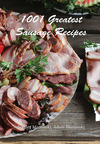Meats and Sausages
Smoked Sausages
Nothing improves the flavor of a sausage in such a rapid and inexpensive way as submitting it to a smoking process. In countries such as Poland and Germany smoked meats account for 60% of all ready-to-eat meat products. In the USA, the variety of sausages in supermarkets pale compared to their European counterparts. Statistically, smoked sausages control a large share of the American market, but most credit goes to emulsified and lightly smoked sausages such as hotdogs, frankfurters, or bolognas. Today, the manufacture of smoked sausages conforms to different criteria. and smoke is added purely for the love of the flavor. Many products are not smoked with hardwood but receive liquid smoke instead. This is accomplished by adding liquid smoke during mixing or showering sausages with a liquid smoke spray. As the synthetic casings can be ordered in mahogany color, such a liquid smoke-enriched sausage can easily pass as the original to the untrained person.
In the past, sausages were smoked for different reasons. Our ancestors did not care much about the flavor of the meat or the sausage. What they needed was a method that would preserve food for later use. They tried different ways to preserve meat, eventually leading to methods like salt curing, drying, smoking, and fermenting. It was discovered that salted meats could be air-dried and would keep for a long time. Soon, two different methods of drying developed. In Northern European countries, winters were cold, meats could be dried at low temperatures, placing them close to the fire. Originally in caves where fire was the center of all social activities, separate enclosures (smokehouses) were built for drying and storing meats much later. As the temperature had to be higher than freezing temperatures outside, the fire was slowly burning on the ground, providing suitable temperatures for drying. It is common knowledge that fire produces smoke, so the meats were dried and smoked at the same time. They were just flavored with cold smoke, which further preserved the product and gave it a wonderful aroma. In addition, it prevented molds from growing on the surface. Our ancestors did not ignore the advantages of applying smoke, and smoking became an art. This does not deny the fact that the main method of preserving meat was drying, and the smoky flavor was just a bonus.
This can be easily observed by studying drying methods in Southern Europe. The moderate climate was less humid, the slightly blowing winds were ever present, and meats were easily dried in the open air for most of the year. Burning fires were hardly needed, and hams and sausages were produced by drying. Spanish chorizos or Italian salamis were made by drying, and meat smoking never became so popular as in the North.
For more information, see the smoked sausage type.
















